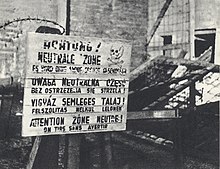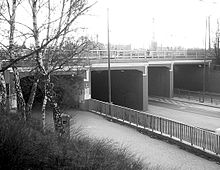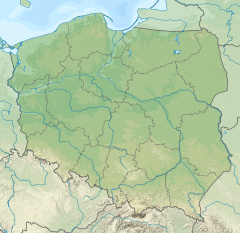Warsaw concentration camp: Difference between revisions
Undid revision 920759635 by Banana Republic (talk) restore since the baby was thrown away with the bathwater in this edit: https://en.wikipedia.org/w/index.php?title=Warsaw_concentration_camp&diff=920898175&oldid=920876851 |
Conflict of interest editing undone. |
||
| Line 81: | Line 81: | ||
According to journalist {{ill|Beata Chomątowska|pl}}, the dynamics of the debunked conspiracy theory surrounding the Warsaw concentration camp are similar to the [[Smolensk air disaster#Conspiracy theories|conspiracy theories surrounding the Smolensk air disaster]].<ref name=wyborcza20170418/> |
According to journalist {{ill|Beata Chomątowska|pl}}, the dynamics of the debunked conspiracy theory surrounding the Warsaw concentration camp are similar to the [[Smolensk air disaster#Conspiracy theories|conspiracy theories surrounding the Smolensk air disaster]].<ref name=wyborcza20170418/> |
||
===Presentation on Wikipedia of the conspiracy theory as fact=== |
|||
An [[English Wikipedia]] article about the Warsaw concentration camp was first drafted by Krzysztof Machocki in August 2004. Machocki was a well-known Wikipedia editor, and also served as the spokesperson for the Polish branch of [[Wikimedia]]. Machocki wrote the conspiracy theory into the article, presenting it as fact. The error was not discovered for 15 years, until August 2019, leading people to call it "Wikipedia’s longest-standing hoax". Machocki died prior to the discovery of the error.<ref>{{cite news |work=[[Haaretz]] |url=https://www.haaretz.com/israel-news/.premium.MAGAZINE-the-fake-nazi-death-camp-wikipedia-s-longest-hoax-exposed-1.7942233 |title=The Fake Nazi Death Camp: Wikipedia’s Longest Hoax, Exposed |date=4 October 2019 |first=Omer |last=Benjakob}}</ref> |
|||
==External links== |
==External links== |
||
* [https://sztetl.org.pl/en/towns/w/18-warsaw/116-sites-of-martyrdom/52122-gesiowka-prison-and-nazi-concentration-camp-gesia-street Gęsiówka – a prison and Nazi concentration camp on the Gęsia Street, Virtual Shtetl] |
* [https://sztetl.org.pl/en/towns/w/18-warsaw/116-sites-of-martyrdom/52122-gesiowka-prison-and-nazi-concentration-camp-gesia-street Gęsiówka – a prison and Nazi concentration camp on the Gęsia Street, Virtual Shtetl] |
||
* [https://www.holocausthistoricalsociety.org.uk/contents/naziseasternempire/warsawconcentrationcamp.html Warsaw Concentration Camp at Holocaust Historical Society] |
* [https://www.holocausthistoricalsociety.org.uk/contents/naziseasternempire/warsawconcentrationcamp.html Warsaw Concentration Camp at Holocaust Historical Society] |
||
* {{cite news |work=[[Haaretz]] |url=https://www.haaretz.com/israel-news/.premium.MAGAZINE-the-fake-nazi-death-camp-wikipedia-s-longest-hoax-exposed-1.7942233 |title=The Fake Nazi Death Camp: Wikipedia’s Longest Hoax, Exposed |date=4 October 2019 |first=Omer |last=Benjakob}} |
|||
== References == |
== References == |
||
Revision as of 08:30, 13 October 2019
| Warsaw | |
|---|---|
| Concentration camp | |
 Gęsiówka, part of the camp, on 5 August 1944, following liberation by Polish troops in Warsaw Uprising | |
| Coordinates | 52°14′54.3″N 20°59′23.7″E / 52.248417°N 20.989917°E |
| Location | Warsaw, Poland |
| Operated by | Nazi Germany[1] |
| Commandant | Wilhelm Göcke (June 1943 – September 1943) Nikolaus Herbet (September 1943 – July 1944) Wilhelm Ruppert (July 1944)[1] |
| Original use | Gęsiówka prison[1] |
| Inmates | mostly Jews from countries other than Poland (Greece and Hungary in particular)[1] |
| Number of inmates | 8,000–9,000[1] |
| Killed | 4,000–5,000[1] |
| Liberated by | Home Army during failed uprising, subsequently by Red Army[1] |
The Warsaw concentration camp (German: Konzentrationslager Warschau, also KL Warschau, KZ Warschau, Gęsiówka concentration camp,[2] and Warschau Main Camp[1]) was a Nazi concentration camp built on the ruins of the Warsaw Ghetto, around Gęsiówka prison. A minor camp, the Warsaw camp is absent from most standard Holocaust accounts. Over the course of its operation an estimated 8,000–9,000 prisoners were engaged in slave labor of which 4,000 to 5,000 are estimated to have died in the camp, during the death march from the camp, the Warsaw Uprising, and hiding after the uprising.[1]
The camp, which has little coverage in mainstream historiography,[1] has been at the center of a conspiracy theory that asserts that a giant gas chamber was built in a tunnel near Warszawa Zachodnia station and that 200,000 mainly non-Jewish Poles were exterminated at the site.[3]
History

In February 1943, Heinrich Himmler ordered that local Jews should be placed in a camp to help clear the Warsaw ghetto following its demolition. However, fierce fighting during the Warsaw Ghetto Uprising foiled this plan.[4][5] Following the defeat of the uprising in April, surviving Jews were deported to camps in the vicinity of Lublin, sent to Treblinka extermination camp, or summarily killed.[4] The concentration camp was established in July 1943, but Jewish prisoners were not from Warsaw but rather from other concentration camps in Europe.[4][6] The camp was located at the Gestapo prison (Gęsiówka), which was the only building left intact in the ghetto.[7]
By May 1944, due to deportations of prisoners to other camps as well as the approach of the Soviet army to Warsaw, the camp became a subcamp of Majdanek concentration camp,[4][8] and was named "Lublin concentration camp–Warsaw labor camp" (German: Konzentrationslager Lublin–Arbeitslager Warschau).[1] Originally planned to close on 1 August 1944, in light of the Soviet advance the camp was closed in July.[1] In July 1944 most prisoners, some 4,500, were sent on a death march to Kutno (the first organized Nazi death march in the war), walking some 30 kilometers a day with many murdered on the way.[9][1] From Kutno, they were crammed onto a train (100 men to a boxcar with no food rations) bound to Dachau concentration camp; some 4,000 survived the journey to Dachau.[1] Around 200 of the most exhausted prisoners were killed prior to the march and 300 prisoners volunteered to remain to dismantle the camp.[1]
Some 350 Jewish prisoners remained during the August Warsaw Uprising and were liberated on 4 August 1944 by Polish forces.[4][9] They included dozens of Jews (including 24 women) who were imprisoned in Pawiak and transferred to the camp on 31 July.[1] The vast majority of released Jewish prisoners took part in the uprising, many of them dying during the fighting.[9][1] Those released were mostly Greek and Hungarian Jews, with some Czechoslovakians and Dutch Jews, who knew very little Polish.[2] Morale among Jewish fighters was hurt by displays of antisemitism, with several former Jewish prisoners in combat units killed by antisemitic Poles,[1]: 1514 in particular those associated with the National Armed Forces.[2] After the defeat of the uprising, survivors fled or hid in bunkers, there were some 200 Jewish survivors (former prisoners as well as Jews who hid on the "Aryan" side) when the Soviets entered Warsaw on 17 January 1945.[1] The book "The Bunker" by Charles Goldstein, a camp inmate, recounts his experiences in the camp and survival.[2]
In executions in the ruins of the Warsaw Ghetto (around and in the site of the concentration camp), Bogusław Tadeusz Kopka estimates that the Germans killed some 20,000 people including camp inmates, Polish Jews caught hiding on the "Aryan side" of Warsaw, and Polish Political prisoners.[10][11] The Institute of National Remembrance estimates the number of Poles murdered on site of the camp and executed in its vicinity at 10,000.[12][need quotation to verify]
Demolition and salvage
Prisoners were tasked with clearing 2.6 million cubic meters of rubble, in order to convert the former ghetto into a park,[7] and in order to salvage building materials (mainly scrap metal and bricks) for the German war effort.[1] The demolition and salvage work were hard and perilous labor, carried out at a brisk pace with no regard to loss of life of the prisoners.[1] By June 1944, 10 million square meters were demolished, with some 8,105 tons of metal and 34 million bricks salvaged.[1]
A couple thousand of Polish civilians, who were paid, also worked alongside the Jewish prisoners, as did dozens of German technicians.[1] German constructions firms operated on contract to carry out salvage: Berlinisches Baugeschäft (Berlin, Willy Keymer (Warsaw), Merckle (Ostrów Wielkopolski), Ostdeutscher Tiefbau (Naumburg). The Ostbahn railway company assisted them.[1]
Prisoners

The first transport of some 300 hundred prisoners came from Buchenwald concentration camp,[7] who were German political prisoners and criminals who would be tasked with day-to-day administration of the camp as kapos.[1][2] The German kapo prisoners, in particular those imprisoned as criminals, intimidated the Jewish prisoners and acted towards them with cruelty, seeing them as expendable.[1]
The prisoners were mainly Jewish males from Auschwitz concentration camp, who were selected on the basis of decent physical condition for hard work and not being Polish.[1] Lack of knowledge of Polish was deemed key by the Germans to prevent escape attempts and limit contact with Polish workers who were also employed, though in the November 1943 transport some 50 Polish Jews were included to meet the 1,000 transport quota.[1][2] From August through November 1943, four transports of 3,683 Jews were sent to the camp from Auschwitz,[1] many of them Greek Salonikan Jews.[9][13] In May and June 1944, some 4,000 to 5,000 Hungarian Jews were sent to the camp, to replenish the prisoner workforce that at that point numbered approximately 1,000 and the Germans considered to be depleted.[1][9][6]
A minor camp, the Warsaw camp is absent from most standard Holocaust accounts. Over the course of its operation an estimated 8,000–9,000 prisoners were engaged in slave labor, of which 4,000 to 5,000 are estimated to have died in the camp, during the death march from the camp, the uprising, and hiding after the uprising.[1] Successful escapes were rare, and those caught in the attempt were hanged in front of the assembled prisoner population.[1] Hundreds died due to executions, cruelty, and exhaustion from labor.[1] Following a typhus epidemic which decimated the prisoner population in January through February 1944,[1] only a third of the inmates survived.[2] Survival on the meager rations provided was impossible, and prisoners survived by locating valuables in the rubble and selling them to the Polish civilians who worked alongside them.[1] As such finds became rare late in the camp's operations, many prisoners resorted to extracting gold fillings from their teeth for sale.[1]
German personnel

The camp was first commanded by Wilhelm Göcke until September 1943, then by Nikolaus Herbet and finally Wilhelm Ruppert who commanded the evacuation in July 1944.[1] The Schutzstaffel (SS) force guarding and operating the camp was approximately the size of a company.[1] The original SS unit was gathered from various other camps, including Trawniki concentration camp and Sachsenhausen concentration camp, and following the attachment to Majdanek in May 1944 they were replaced with SS personnel from Lublin.[1]
The SS personnel mainly guarded the perimeter of the camp and were brutally violent towards the Jews, viewing them as enemies of the state.[1]
Following the war, eight SS men from the camp were executed for their role in murder; three were sentenced by a Polish court and five by a German court. Walter Wawrzyniak, who was initially sentenced to death in 1950 by an East German court, had his sentence reduced on appeal to a life term. In July 2000, Theodor Szehinskyj, who immigrated to the US, had his US citizenship stripped as a US court found that he had lied in his initial visa application about his SS past.[1]
Executions in ghetto ruins

Camp inmates, Polish Jews caught hiding on the "Aryan side" of Warsaw, and Polish political prisoners were executed in the ruins of the former ghetto (which surrounded the camp) in 1943-1944. It is impossible to determine the exact number of victims of executions in the ruins, however historian Bogusław Tadeusz Kopka estimates that some 20,000 people were executed in the period. These included camp inmates, Polish Jews caught hiding on the "Aryan side" of Warsaw, and ethnic Poles.[10][11] The ruins of the ghetto supplanted previous execution sites, which were in the countryside around Warsaw, such as the Kampinos Forest (the site of the Palmiry massacre). Executions in the countryside required means of transport and a significant guard details, whereas the ruins of the ghetto were much more accessible to German forces in Warsaw.[14][better source needed]
Conspiracy theory

Despite basic research being available on the camp,[11][15] a legend[11] or conspiracy theory[3][16] developed in Poland around the camp.[3][11] This was first advanced by judge and author Maria Trzcińska in the 1970s and is promoted by Polish nationalists who espouse the "Polocaust" notion. The legend/conspiracy theory claims that the camp was much larger, and functioned as an extermination camp for the non-Jewish population of Warsaw, killing 200,000 mainly non-Jewish Poles. The alleged killing used a giant gas chamber supposedly constructed in the Józef Bem Street tunnel (near Warszawa Zachodnia station)[3] Supporters of "Polocaust" resent the attention the Holocaust receives since they believe the Holocaust to be an exaggeration by Jews.[3] Therefore, promoting a theory that the Germans constructed a gas chamber to kill non-Jews, coupled with the killing of as many as 200,000 additional victims of the Warsaw Uprising (for a total of 400,000 non-Jewish victims in Warsaw), would create a parity between Jewish and non-Jewish Poles, and would make the Holocaust less unique.[3][16]
The nationalist daily Nasz Dziennik has promoted this theory and the camp as a symbol of Polish martyrdom, advocating introduction of material to school curricula and the construction of a museum. Unlike other concentration camps that are extensively covered in historical literature (e.g. the Auschwitz concentration camp), the Warsaw concentration camp is nearly absent in mainstream historiography, allowing Nasz Dziennik to break ground on a "new continent".[17]
According to journalist Beata Chomątowska, the dynamics of the debunked conspiracy theory surrounding the Warsaw concentration camp are similar to the conspiracy theories surrounding the Smolensk air disaster.[16]
Presentation on Wikipedia of the conspiracy theory as fact
An English Wikipedia article about the Warsaw concentration camp was first drafted by Krzysztof Machocki in August 2004. Machocki was a well-known Wikipedia editor, and also served as the spokesperson for the Polish branch of Wikimedia. Machocki wrote the conspiracy theory into the article, presenting it as fact. The error was not discovered for 15 years, until August 2019, leading people to call it "Wikipedia’s longest-standing hoax". Machocki died prior to the discovery of the error.[18]
External links
- Gęsiówka – a prison and Nazi concentration camp on the Gęsia Street, Virtual Shtetl
- Warsaw Concentration Camp at Holocaust Historical Society
References
- ^ a b c d e f g h i j k l m n o p q r s t u v w x y z aa ab ac ad ae af ag ah ai aj ak al am an ao The United States Holocaust Memorial Museum Encyclopedia of Camps and Ghettos, 1933–1945, Geoffrey P. Megargee, Martin Dean, and Mel Hecker, Volume I, part B, pages 1512–1515
- ^ a b c d e f g "The GesiówkaStory: A Little Known Page of Jewish Fighting History.", Edward Kossoy, Yad Vashem Studies 32 (2004): 323–350.
- ^ a b c d e f Under the Railway Line, London Review of Books, Christian Davies, Vol. 41 No. 9, 9 May 2019
- ^ a b c d e Concentration Camps in Nazi Germany: The New Histories, Routledge, 2010, chapter by Dieter Pohl, page 156–157 in print version (no page numbers in e-book)
- ^ Der Ort des Terrors. Geschichte der nationalsozialistischen Konzentrationslager Band. 8: Riga-Kaiserwald, Warschau, Vaivara, Kauen (Kaunas), Plaszów, Kulmhof/Chelmno, Belzéc, Sobibór, Treblinka. chapter: Konzentrationslager Warschau, C.H. Beck, chapter by Andreas Mix, 2008, page 91
- ^ a b Letter to My Children: From Romania to America Via Auschwitz, Missouri University Press, Rudolph Tessler, page 65
- ^ a b c The Order of Terror: The Concentration Camp, Princeton University Press, 1997, Wolfgang Sofsky page 337
- ^ Odilo Globocnik, Hitler's Man in the East, McFarland & Company, Joseph Poprzeczny, 2004, pages 222–223
- ^ a b c d e Clearing the Ruins of the Ghetto, Yad Vashem
- ^ a b Bogusław Kopka: Konzentrationslager Warschau... op.cit, p. 16 and 120.
- ^ a b c d e Review: New Polish Research on German Violent Crimes in the Second World War, Sehepunkte 2010 no. 6, Stephan Lehnstaedt
- ^ Bogusław Kopka: Konzentrationslager Warschau. Historia i następstwa. Warszawa: Instytut Pamięci Narodowej, 2007. ISBN 978-83-60464-46-5. Page 16
- ^ Zezza, Stefania. "In Their Own Voices." Trauma and Memory 4.3 (2016): 90–118.
- ^ „Terror nie ustaje” – 75. rocznica masowych egzekucji w ruinach getta warszawskiego, 29 May 2018, dzieje.pl
- ^ M. Trzcinska: Konzentrationslager Warschau, H-Soz-Kult, Andreas Mix (Center for Research on Antisemitism), 2003
- ^ a b c KL Warschau jak katastrofa smoleńska, czyli manipulacja pamięcią, FELIETON CHOMĄTOWSKIEJ, Gazeta Wyborcza, Beata Chomątowska, 18 April 2017
- ^ Kwiatkowska, Hanna Maria. Conflict of images. Conflict of memories. Jewish themes in the polish right-wing nationalistic press in the light of articles from nasz dziennik 1998-2007. Diss. University of London, 2008, pages 67, 82-88
- ^ Benjakob, Omer (4 October 2019). "The Fake Nazi Death Camp: Wikipedia's Longest Hoax, Exposed". Haaretz.

